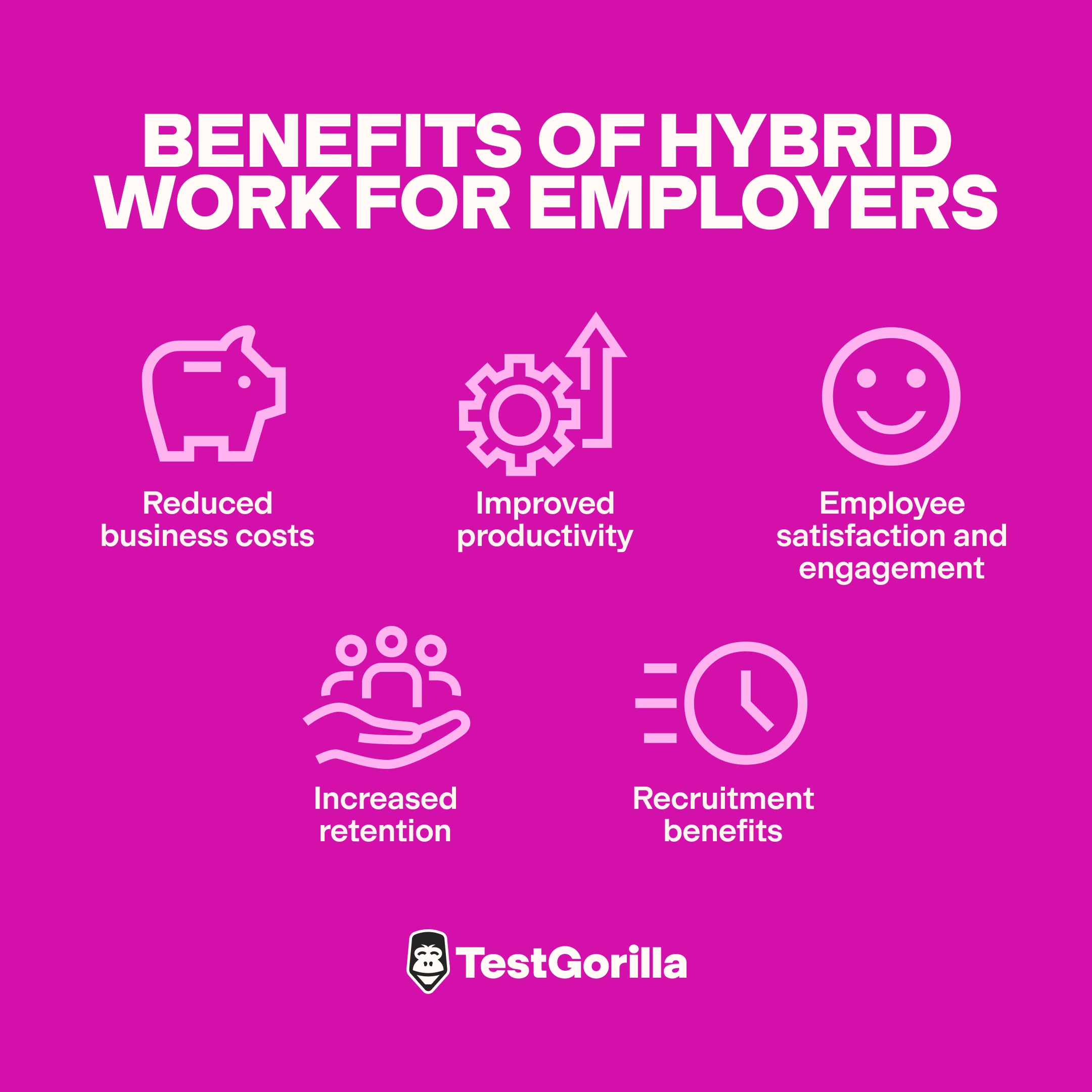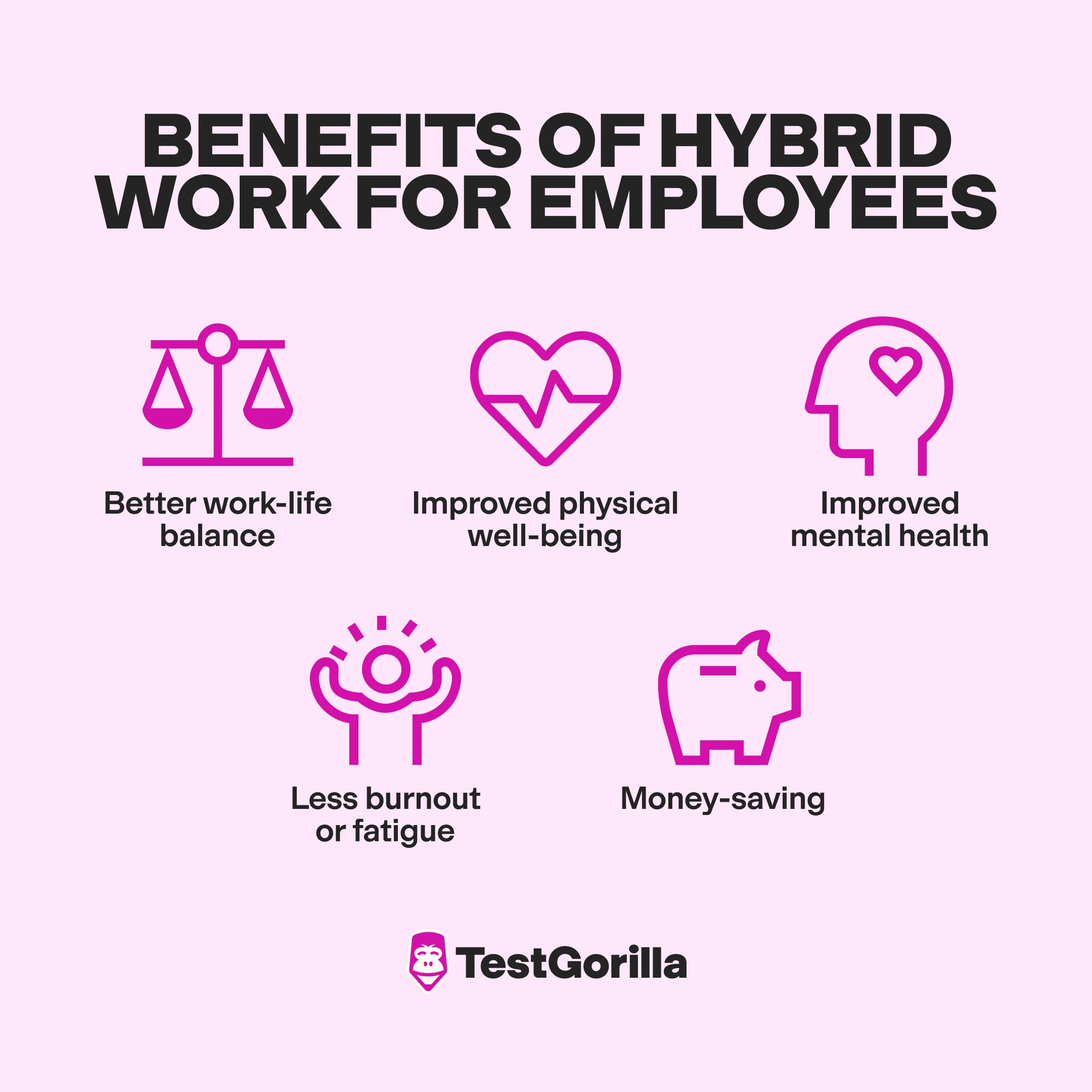Several large organizations – including Dell and Amazon – recently announced mandatory, full-time return-to-office mandates. Despite this, hybrid work remains a popular compromise for many employers and their employees.
But what benefits does hybrid work offer businesses and workers, what challenges does it raise, and how can employers implement it strategically?
In this article, we answer these questions and more by diving into key hybrid work statistics.
How we researched this topic
We reviewed various studies and surveys on hybrid work from large consulting firms like Gallup and reports from several remote working software companies. We also drew from recent academic research on remote and hybrid work, including from researchers at Stanford University.
Most of the sources in this article are less than three years old.
Key takeaways
Hybrid work allows employees to work a combination of days from the office and remotely.
This working model benefits both employers and employees, offering increased productivity, job satisfaction, and cost savings.
However, it can also pose challenges regarding communication and collaboration, cybersecurity, and employee career progression.
Luckily, you can approach hybrid work in several ways to ensure it’s as effective as possible.
By reading statistics on hybrid work, we can gain further insights into what works and doesn’t.
What is hybrid work?
Hybrid work is a working model that allows employees to work from the office and another location, typically their home.
Hybrid workers are between in-office workers, who are present in the office five days a week, and fully remote workers, who work from home five days a week.
While it doesn’t suit every business model or industry, hybrid work can offer a good compromise between employees who want the flexibility of working from home and employers who demand staff return to the office full-time.
The current state of hybrid work
Following the COVID-19 pandemic, many employers adopted a hybrid work model – and this trend looks to continue.
Here’s what the stats tell us:
As of May 2024, 53% of employees in remote-capable jobs are hybrid workers. This represents a slight increase in the number of hybrid workers from the same time in the previous year.
The average number of days hybrid workers spend in the office weekly is 2.6. The most common days are Tuesdays, Wednesdays, and Thursdays.
Working from home is more common in English-speaking countries.
The option to work from home is most common in these sectors:
Finance and insurance.
Information (including tech).
Personal and business services.
Hybrid work is most popular with Gen Z employees, with 65% saying they prefer it, compared to 60% of Millennials, 58% of Gen X individuals, and 56% of Baby Boomers.
Senior-level roles (with five or more years of experience) offer greater access to flexible work arrangements, with 29% of new roles offering hybrid work, compared to 22% of mid-level jobs and 17% of entry-level positions.
The best insights on HR and recruitment, delivered to your inbox.
Biweekly updates. No spam. Unsubscribe any time.
Benefits of hybrid work for employers
Reduced business costs
90% of CEOs say hybrid working has helped them reduce business costs.
Businesses can save up to 40% of their office space costs by reducing the need for physical space under a hybrid work model.
The average employer saves approximately $11,000 annually for every hybrid worker who spends half their week working remotely.
Improved productivity
63% of CEOs say they see increased worker productivity after switching to a hybrid model.
With effective management, hybrid teams can increase their productivity by up to 20%.
Enhanced employee satisfaction and engagement
One company improved its employee net promoter score (eNPS) by 34% after adopting a remote-first policy.
17.4% of hybrid workers are likely to express negative feelings about their jobs, compared to 21.6% of in-office workers.
While more research is needed, the data suggests that hybrid employees who work onsite three days a week are more engaged.
Increased retention
59% of CEOs report that hybrid work has improved employee attraction and retention.
In one study of over 1,600 workers at a Chinese company, resignations decreased by 33% for workers who moved from an in-office model to a hybrid one.
41% of employees say they would look for another employer that offered more flexibility if they couldn’t continue hybrid working in their current jobs.
Recruitment benefits
One employer improved its time-to-hire rate by 31% by introducing a remote-first work policy.
Benefits of hybrid work for employees
For 76% of hybrid workers, a better work-life balance is the most significant benefit of hybrid work.
Research shows that hybrid work helps employees improve their physical well-being. Hybrid workers exercise almost 90 minutes longer each week than they did before the pandemic and sleep an extra 71 hours by avoiding the commute.
Hybrid work offers benefits for employees’ mental health. 79% of hybrid workers feel less drained, 78% less stressed, and 72% less anxious.
61% of hybrid employees report experiencing less burnout or fatigue at work.
Like businesses, employees can also save money. Working remotely half the week is estimated to save individuals $2,500 to $4,000 annually.
Challenges of hybrid work
Of course, hybrid work also has its downsides. Let’s dig into the data to see the disadvantages of this work model.
Communication and collaboration issues
24% of hybrid workers report decreased collaboration, while 53% feel that working from home negatively impacts their connection with colleagues.
25% of employees agree that there are fewer opportunities to learn from their colleagues when working remotely.
40% of workers find participating in hybrid meetings challenging.
Weakened company culture
28% of hybrid workers feel less connected to their company’s culture.
Over a third of business leaders describe remote work as weakening culture.
Bad employee habits
Hybrid work may encourage unproductive habits. 44% of employees admit to “coffee badging” at work – attending the office briefly to make sure they’re seen and then returning home as a way to comply with employer attendance policies.
72% of hybrid and fully remote workers are less likely to take a sick day when unwell. This may affect their recovery and the quality of their work.
Barriers to career progression
Some hybrid workers worry they’re less visible to management, with 27% of hybrid workers feeling they have been overlooked for career advancement opportunities.
42% of remote workers worry about being chosen for project opportunities and promotions. This concern is valid, given that 42% of managers occasionally forget about remote workers when delegating tasks.
Cybersecurity concerns
85% of companies in the UK believe remote and hybrid work are contributing factors to increased cybersecurity threats.
However, only 55% of hybrid workers say their organizations have specific data privacy and security guidelines.
Strategies for supporting hybrid work
Interested in introducing hybrid work at your organization, or simply want to strengthen your existing model? Here are two top strategies to follow:
Invest in the right technology and tools
72% of workers say their employer needs to invest in new technologies to support remote work. For example, collaboration software helps employees easily work together on projects, regardless of location.
However, just 43% of workers say their company has introduced digital collaboration tools, and 39% say their employer has set up meeting rooms to facilitate in-office and remote meetings.
Employers recognize this gap and are taking steps to address it. 73% of employers intend to invest in AI collaboration software by 2025.
Develop a clear hybrid work policy
Only a third of employers have formal hybrid work rules, with almost half (48%) using informal and ambiguous guidelines instead.
Consider creating or refining your policy based on the level of freedom you want (or are able) to give employees. Five in ten hybrid workers are required to work a certain number of days or specific days on-site each week. Three in ten can choose how many days and when they work on-site, while one in ten workers are encouraged to work a certain number of days or specific days on-site each week.
Hybrid workers are more engaged when their team decides on their hybrid schedule together. However, only 12% of hybrid workers report that their organization is taking this approach. So, to improve outcomes, involve your team members in creating or updating your hybrid work policy.
Use talent assessments to hire top hybrid workers
While a hybrid working model can present some challenges – including barriers to collaboration, weakened company culture, and cybersecurity issues – there’s also much to gain. Hybrid employees are often more productive and have higher job satisfaction. Plus, the model offers huge potential cost savings for employers.
Pre-employment talent assessments, like TestGorilla’s, are a great way to hire hybrid workers. You can assess their technical strengths and key soft skills – such as flexibility, adaptability, and effective communication – that will help them thrive in a hybrid work environment.
Find out how TestGorilla can help you hire effective hybrid workers by booking a free demo or signing up for our free plan today!
FAQs
Is hybrid working more effective?
Hybrid work can lead to happier, more productive employees who can do their jobs more effectively than those working in the office full-time. These individuals also have the flexibility to optimize their work environment, which can reduce stress. Plus, hybrid work offers long-term cost savings to businesses while boosting engagement and retention.
Are people happier working hybrid?
Hybrid workers often experience greater job satisfaction and are generally happier at work. They appreciate flexibility and a better work-life balance, which allows them to switch off from work properly, spend time with friends and family, or do activities they enjoy.
Is remote work going away in 2025?
Remote work looks set to continue in 2025. Employees like it because it improves their work-life balance, and they’re willing to look elsewhere if an employer can’t offer it. Employers are responding to this and being rewarded with increased employee retention, productivity, and cost savings.
You've scrolled this far
Why not try TestGorilla for free, and see what happens when you put skills first.




















